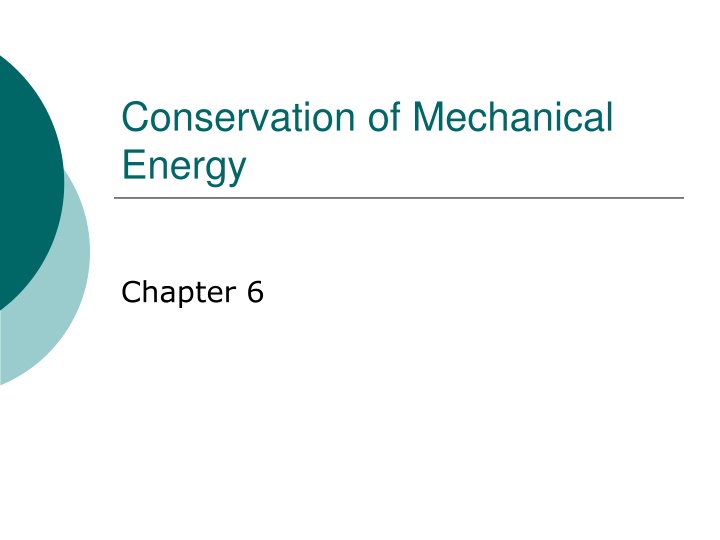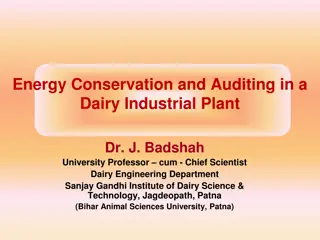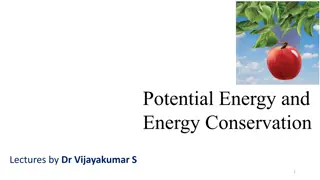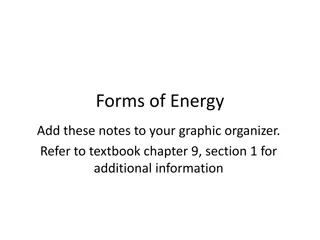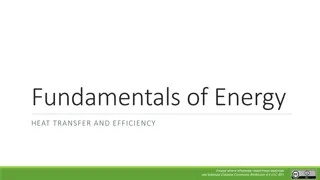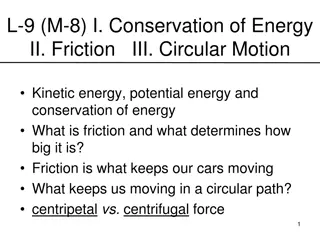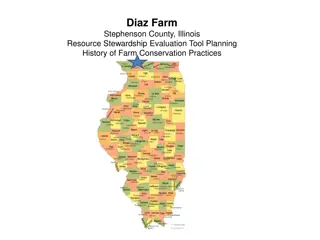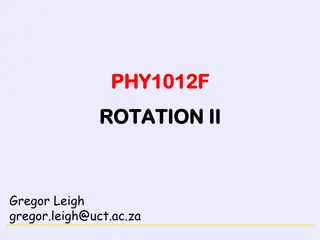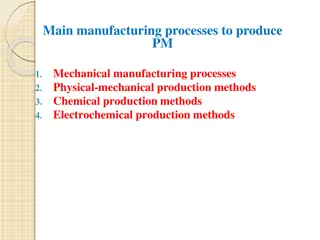Conservation of Mechanical Energy Explained
Explore the concept of conservation of mechanical energy in Chapter 6, including kinetic energy, potential energy, and various forms of energy. Learn about the law of conservation of energy and its application to different systems, as well as conserved quantities like mass, momentum, and charge. Discover critical points in the conservation of mechanical energy, such as maximizing potential and kinetic energy, and consider examples to deepen your understanding.
Download Presentation

Please find below an Image/Link to download the presentation.
The content on the website is provided AS IS for your information and personal use only. It may not be sold, licensed, or shared on other websites without obtaining consent from the author.If you encounter any issues during the download, it is possible that the publisher has removed the file from their server.
You are allowed to download the files provided on this website for personal or commercial use, subject to the condition that they are used lawfully. All files are the property of their respective owners.
The content on the website is provided AS IS for your information and personal use only. It may not be sold, licensed, or shared on other websites without obtaining consent from the author.
E N D
Presentation Transcript
Conservation of Mechanical Energy Chapter 6
Energy As you know, energy comes in many forms. Kinetic Energy Potential Energy Gravitational Potential Energy (gravity) Elastic Potential Energy (springs, rubber bands) Chemical Energy (chemical bonds) Rest Mass Energy = Nuclear (E = mc2) Electric Potential Energy ( U = kq1q2/r) Thermal Energy (heat = KE of molecules) Sound (waves) Light (waves/photons) What does it mean to conserve energy?
Conservation of Energy The Law of Conservation of Energy simply states that: The energy of a system is constant. Energy cannot be created nor destroyed. Energy can only change form (e.g. electrical to kinetic to potential, etc). True for any system with no external forces. 1. 2. 3. ETotal= KE + PE = Constant KE = Kinetic Energy PE = Potential Energy
Conserved Quantities Some conserved quantities that you may or may not already be familiar with? Conservation of mass. Conservation of momentum. Conservation of charge.
Conservation of Energy Energy Mechanical Non-mechanical Potential Kinetic Elastic Gravitational
ET = KE + PE = Constant What does it mean if the energy of a system is constant? If the Potential Energy is at a maximum, then the system will have minimum Kinetic Energy. If the Kinetic Energy is at a maximum, then the system will have minimum Potential Energy. PEMax KEMin PEMin KEMax
Conservation of Mechanical Energy ET = KE + PE KEinitial + PEinitial = KEfinal + PEfinal
Conservation of Mechanical Energy Skier Critical points to consider PE max Work don by friction Total Mechanical Energy Heat (Q) KE max Total Mechanical Energy = PE + KE When friction is present: ETotal = KE + PE + Q Friction is a non-conservative force that takes energy from the system
Example 1: A student with a mass of 55 kg starts from rest and slides down a frictionless slide that is 3 meters high. What is the student s kinetic energy at the bottom of the slide. What is the student s speed at the bottom of the slide? KEinitial + PEinitial = KEfinal + PEfinal KEinitial = 0 because v is 0 at top of slide. PEinitial = mgh KEfinal = mv2 PEfinal = 0 at bottom of slide. 1. 2.
Example 1 (cont.) 1. PEinitial = KEfinal mgh = KEfinal KEfinal = (55kg)(9.81m/s2)(3.0m) KEfinal = 1620 Joules 2. KEfinal = mv2 v = 2KE/m v = (2)(1620J)/(55kg) v = 7.67 m/s
Example 2: El Toro goes through a vertical drop of 50 meters. Using the conservation of energy, determine the speed at the bottom of the drop. Assume that the initial speed of the coaster is 0 m/s.
The conservation of energy says that the kinetic energy at the bottom of the drop will equal the gravitational potential energy at the top. ?? = ?? ??2= ?? Divide both sides by m to get: ?2 = ? Then multiply both sides by 2 to get: ?2 = 2? Take the square root of both sides to get: 2? ? = (2)(9.81 ?/?2)(50 ?) = 31.3 ?/? (69.3 ?? ) ? =
Example 3: A student with a mass of 55 kg starts from rest and slides down a non-frictionless slide that is 3 meters high. Compared to a frictionless slide the student s speed will be: the same. less than. more than. Why? Because energy is lost to the environment in the form of heat due to friction. a. b. c.
Example 3 (cont.) Does this example reflect conservation of mechanical energy? No, because of friction. Friction causes energy to flow from the system to the environment. Is the law of conservation of energy violated? No: as previously stated, some of the mechanical energy is lost to the environment in the form of heat.
Conservation of Mechanical Energy Mechanical Energy: If Internal Energy(Q) is ignored: ET = KE + GPE + PEs PE could be a combination of gravitational and elastic potential energy, or any other form of potential energy.
Conservation of Mechanical Energy The Roller Coaster www.howstuffworks.com
